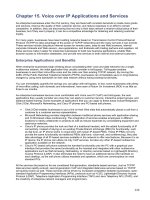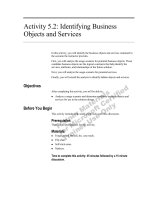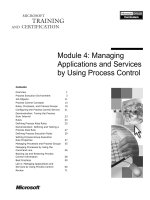Communications and Services Certifications
Bạn đang xem bản rút gọn của tài liệu. Xem và tải ngay bản đầy đủ của tài liệu tại đây (2.5 MB, 198 trang )
2
Communications and Services
Certifications
3
4
CCNA Exam
Exam Number - 640-801
Total Marks - 1000
Duration – 90 Mts
Passing score – 849
Questions -45-55
Multiple Choice
Simulations
Drag and Drop
5
Benefits
Peer Validation
Personal
Potential Employer
Career advancement
6
Cisco Icons and Symbols
7
Data Networks
Sharing data through the use of floppy disks is not an
efficient or cost-effective manner.
Businesses needed a solution that would successfully address
the following three problems:
•
How to avoid duplication of equipment and resources
•
How to communicate efficiently
•
How to set up and manage a network
Businesses realized that networking technology could increase
productivity while saving money.
8
Networking Devices
Equipment that connects directly to a network segment is
referred to as a device.
These devices are broken up into two classifications.
End-user devices
Network devices
End-user devices include computers, printers, scanners, and
other devices that provide services directly to the user.
Network devices include all the devices that connect the end-
user devices together to allow them to communicate.
9
Network Interface Card
A network interface card (NIC) is a printed circuit board
that provides network communication capabilities to and
from a personal computer. Also called a LAN adapter.
10
Hub
Connects a group of Hosts
11
Switch
Switches add more
intelligence to data transfer
management.
12
Router
Routers are used to connect networks together
Route packets of data from one network to another
Cisco became the de facto standard of routers because of their high-
quality router products
Routers, by default, break up a
broadcast domain
13
Network Topologies
Network topology defines the structure of the network.
One part of the topology definition is the physical topology,
which is the actual layout of the wire or media.
The other part is the logical topology,which defines how the
media is accessed by the hosts for sending data.
14
Bus Topology
A bus topology uses a single backbone cable that is
terminated at both ends.
All the hosts connect directly to this backbone.
15
Ring Topology
A ring topology connects one host to the next and the last
host to the first.
This creates a physical ring of cable.
16
Star Topology
A star topology connects all cables to a central point of
concentration.
17
Extended Star Topology
An extended star topology links individual stars together by
connecting the hubs and/or switches.This topology can
extend the scope and coverage of the network.
18
Mesh Topology
A mesh topology is implemented to provide as much
protection as possible from interruption of service.
Each host has its own connections to all other hosts.
Although the Internet has multiple paths to any one
location, it does not adopt the full mesh topology.
19
Physical and Logical Topology
20
LANs, MANs, & WANs
One early solution was the creation of local-area network
(LAN) standards which provided an open set of guidelines for
creating network hardware and software, making equipment
from different companies compatible.
What was needed was a way for information to move
efficiently and quickly, not only within a company, but also
from one business to another.
The solution was the creation of metropolitan-area
networks (MANs) and wide-area networks (WANs).
21
LANs
22
WANs
23
Virtual Private Network
A VPN is a private network that is constructed within a public network
infrastructure such as the global Internet. Using VPN, a telecommuter
can access the network of the company headquarters through the
Internet by building a secure tunnel between the telecommuter’s PC
and a VPN router in the headquarters.
24
Bandwidth
25
Measuring Bandwidth









